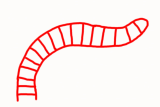[005] Peristalsis (GB#105B01) | 基礎医学教育研究会(KIKKEN)Lab

● Intestinal movement is controlled by the intestines themselves
Entered food is crushed and mixed and escaped from the esophagus into the stomach and intestine.
This flow can not be done even if there is a strong pump somewhere like blood. Then, it gets clogged as soon as it is sticky. This substance must be sent to its place, the next following place at that place. What is responsible for this flow is the peristaltic movement of the gastrointestinal tract.
—
Contents
- 1 ● The tube is made of smooth muscle
- 2 ● Peristalsis occurs with relays of muscle contraction
- 3 ● Relaxation of contraction and relaxation is controlled by the nervous system of the intestines
- 4 ● Earthworm forward movement
- 5 ● Illness without intestinal nervous system
- 6 ● Urine is also carried with peristalsis
- 7 The entrance of the digestive tract is peristaltic motion with skeletal muscle
- 8 ○ Referenced sites
- 9 ○ Related articles
- 10 ○ Referenced books
● The tube is made of smooth muscle
Basically the gastrointestinal tract is made up of two layers of muscle walls that shrink in different directions. The inner layer is a circular muscle in which the muscles are arranged in a ring shape, and when it contracts, the tube is narrowed down. The longitudinal layer is the longitudinal muscle with the muscle fibers aligned in the longitudinal direction of the duct, and when it contracts the length of the tube shortens.Both are made of smooth muscle.
● Peristalsis occurs with relays of muscle contraction
The longitudinal muscle works by tensioning so that the tube does not extend vertically. In peristalsis, the contraction and relaxation of the partial circular muscle progress in a fixed direction so that it flows in a relay system. While the recipient’s circular muscle loosens, the sending-side circular muscle narrows the tube and flushes the contents as a set. When the wall of the gastrointestinal tract is expanded with the contents moved, a reaction that the wall contracts strongly automatically occurs a little after a lapse, and when it is repeated, transfer of the spontaneously occurs due to peristalsis.
● Relaxation of contraction and relaxation is controlled by the nervous system of the intestines
These series of muscle movements need nerve control. The digestive tract has its own special neural network for this purpose.
That is the network of the autonomic nervous system called Auerbach’s plexus and Meissner’s plexus between the circular muscle and the longitudinal muscle. At first glance it looks like a net with oranges selling in town is a plexus. Originally, the central nerve refers to the brain and spinal cord, and the rest is the peripheral nerve. However, the network of autonomic nerves of the gastrointestinal tract is said to be another central nerve. The Auerbach plexus and Meissner plexus control the condition of gastrointestinal motility by themselves by the function of reflex depending on the condition of digestion.
Since it is not very intelligent, basically peristalsis is decided in one direction from the mouth to the anus. There is a firm name “law of intestine”. The nerves from the brain and spinal cord control the degree of activity, but they seem to be unable to control up to the direction of exercise.
* Since the direction of peristalsis is provided in the making of the tube itself, if it is desired to reverse the peristalsis in a certain part for some reason, cut both ends of the part by surgery and sew it in the opposite direction.
-⇒ About intestinal inverse peristaltic interposition
—
* In the ascending colon in the large intestine, ‘reverse peristalsis’ occurs. If the mass moves from top to bottom of the ascending colon it will be in the opposite direction of normal peristalsis, but how is it actually (apparently so).The reverse peristalsis of the ascending colon has a function to deliberately store it to remove water from the mass.There is a description that in the duodenum connecting the stomach and the jejunum, reverse peristalsis also occurs in the small intestine.
· There is contraction of Cannon-Bohm point or Haustra (= haustra coli), and movement of colon seems to be surprisingly complicated.
● Earthworm forward movement

Earthworm crawling movement also expresses the same word as peristaltic in Japan, but this time, longitudinal motors are mainly contracting and relaxing repeatedly, the movement pattern is actually different. In English, this one has another name called vermiculation.
⇒Earthworm robot
● Illness without intestinal nervous system
There is Hirschsprung’s disease, in which intramural plexus to control intestinal motility is not congenitally formed. Although it seems to be partially lost or lost over a considerably long distance, the extent is variable, but since the movement of the intestinal tract does not occur in places with no plexus, digestion and absorption of nutrients are greatly hindered. Recently, part of the mechanism of the onset of this disease is said to have been understood by rat experiments.
⇒Elucidation of the mechanism by which intestinal nervous system is formed called “second brain” with mouse(August 2012)
● Urine is also carried with peristalsis
Not only the gastrointestinal tract carries things with peristalsis of the duct. The ureter that carries the urine just made from the kidney to the bladder little by little also performs a peristaltic motion. Even if urine accumulates in the bladder, it is a device that does not cause a burden of backflow to the kidney.
The entrance of the digestive tract is peristaltic motion with skeletal muscle
From the middle of the esophagus of the gastrointestinal tract to the anus, peristalsis automatically advances with a smooth muscle and a network of autonomic nervous systems surrounding it. However, since the upper one third of the esophagus is made up of skeletal muscles, although the behavior when swallowing is peristaltic, the mechanism is different from the peristalsis of the underlying smooth muscle.The central nervous system to be controlled is located in the medulla oblongata outside the duct, and from there it causes a swallowing movement like a peristaltic motion. Since this is controlled by a proper brain, it can be stopped half way or extruded in the reverse direction depending on circumstances.
○ Referenced sites
⇒Those who want to know more about intestinal supernatural powers … “Intestinal mystery”
⇒People who want to know more about smooth muscle
⇒If you would like to know more about the small intestine
⇒For more information on the Auerbach plexus
⇒Example of reverse peristalsis of small intestine / large intestine, Noritsugu Tose, Nippon Keizai Shimpo, 2016-10-18.
⇒If you would like to know more about earthworms
○ Related articles
◆[022] 胃と十二指腸 the stomach and the duodenum ![]()
◆[012] 分節運動 intestinal segmentation ![]()
◆[033] 平滑筋の収縮 smooth muscle contraction ![]()
◆[008] 弁の働き valve in the thin‐walled vessel ![]()
◆[054] switching of the airway and esophagus (GB#105A04)![]()
◆[017] 糖質の吸収 absorption of carbohydratel ![]()
◆[035] 骨格筋収縮の張力 tension of the skeletal muscle contraction ![]()
◆[046] digestion and metabolism ![]()
○ Referenced books
・カラー図解 人体の正常構造と機能 全10巻縮刷版,坂井 建雄,日本医事新報社
・人体機能生理学,杉 晴夫,南江堂
・トートラ人体解剖生理学 原書8版,丸善
・イラスト解剖学,松村 讓兒,中外医学社
・柔道整復学校協会編「生理学」,南江堂
・東洋療法学校協会編「生理学」,医歯薬出版株式会社
rev.20150713,rev.2016403,rev.20161215,rev.20170205,rev.20170502, rev.20170909.
KISO-IGAKU-KYOIKU-KENKYUKAI(KIKKEN)







